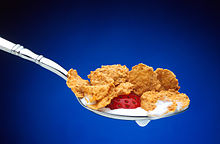Healthy eating habits/Healthy Eating for Busy Adults

Breakfast and Healthy Eating[edit | edit source]
On average, nearly 1 in 5 Australian adults skip breakfast at least 3 days per week.[1]. Breakfast is one of the most important meals of the day as it helps refuel your body for the day ahead.[2]
When you eat a healthy breakfast, you're more likely to:
- Eat more vitamins and minerals.[2]
- Eat less fat and Cholesterol:, which may reduce your risk of heart disease. [2]
- Have better concentration and productivity throughout the morning.[2]
- Control your weight. [2]

Simple tips to make sure you include breakfast[edit | edit source]
- Prepare meals the night before.[3]
- Prepare a breakfast to eat on the go or grab something quick such as fruit or cheese and crackers.[3]
- Keep breakfast ingredients at work so you can eat when you arrive at work.[3]
- Set your alarm 10 minutes earlier.[3]
Eating healthy when you are short on time[edit | edit source]
- Cook in bulk on the weekend and keep meals in the freezer to use for during the week.[4]
- Grab fruit when on the go.[4]
- Use a microwave, it’s easier and faster to microwave foods than cook them in the oven or on the stove.[4]
- Use small, thin pieces of food as it cooks quicker.[4]
- Don’t throw out leftovers, keep them for a quick meal the next day.[4]
- Prepare lunches the night before to avoid preparing in the morning.[4]

Why are vegetables important to include in the diet?[edit | edit source]
Many Australians only eat about half the recommended quantity of vegetables per day. [5] Vegetables provide vitamins, minerals, dietary fibre and many other nutrients naturally present in plants.[5] Most vegetables are low in energy compared to many other foods, and may help ‘fill us up’ to avoid excessive weight gain too.[5] Diets high in vegetables may help protect you from chronic diseases including heart disease, stroke and some cancers.[5]
What is a serve of vegetables?[5][edit | edit source]
- ½ cup of cooked green or orange vegetables
- ½ medium potato or other starchy vegetables
- 1 cup of green leafy vegetables or salad
- ½ cup cooked dried or canned beans, peas or lentils
How many serves of vegetables should I be eating a day?[5][edit | edit source]
| 19-50 Years | 51-70 Years | 70+ Years | |
|---|---|---|---|
| Men | 6 | 5.5 | 5 |
| Women | 5 | 5 | 5 |
Making Fast Food Healthy[edit | edit source]
Takeaway can be a regular habit for busy people, so If you happen to be too busy to prepare meals and go for takeaway try and choose healthier choices.[6] Most restaurants and cafes now serve lower fat, healthier options, however a lot of take-away foods often contain hidden fats.[6]
Tips for choosing healthier takeaway foods[edit | edit source]
- Try to avoid anything that is fried or battered
- Avoid foods cooked in cream or butter such as butter chicken.[6]
- Avoid high fat meats such as processed meats and sausages and choose leaner meats like turkey, ham, chicken and roast beef.[6]
- Try to avoid meal combos which include fries and soft drinks and just get the burger
- Share an entrée with a friend
- Order from the child's menu
- Order the lunch or appetizer version of your meal
- Choose burgers with salad rather than ‘the lot’, and ask for no mayonnaise or margarine on the bun.[6]
- Order souvlaki or kebabs with extra salad rather than lots of meat.[6]
- Try thin crust pizza with lean meat or lean chicken with plenty of vegetarian toppings.[6]
- Choose pasta with tomato-based sauces instead of cream based.[6]
- Choose steamed rice over fried rice.[6]
- Eat plenty of vegetables with stir-fry dishes.[6]
- Drink low-fat smoothies, milkshakes and coffee or tea.[6]
- Try to avoid ordering dessert, or try low-fat frozen yoghurt, ice creams or fruit.[6]
- Put left overs into a doggie bag instead of trying to finish the meal
- Try to avoid or limit dressings, sauces and gravies
- Ask salad instead of chips
- Choose lower fat dressings and sauces
- Choose low-fat muffins instead of regular muffins, danishes or croissants
- Ask for your bread without butter
Key Points[edit | edit source]
- Try to eat breakfast every day
- There are many ways you can include breakfast in your diet
- Cooking healthy meals can be made quicker
- Vegetables are important in the diet, try and meet your recommended serves per day
- Choose healthier choices when eating take away
Further Reading[edit | edit source]
- http://daa.asn.au/for-the-public/smart-eating-for-you/nutrition-a-z/breakfast/
- http://www.eatforhealth.gov.au/
- http://www.health.qld.gov.au/nutrition/resources/wtmgt_takeaway.pdf
- http://www.nutritionaustralia.org/national/resource/healthy-lunch-ideas-busy-adults
References[edit | edit source]
- ↑ Australian Bureau of Statistics. (1995). National Nutrition Survey Selected Highlights Australia. Retrieved from http://www.ausstats.abs.gov.au/ausstats/free.nsf/0/236465EA4E9B3D2BCA25722500049629/$File/48020_1995.pdf.
- ↑ a b c d e Dietitians Association of Australia. (2013). Breakfast. Retrieved from http://daa.asn.au/for-the-public/smart-eating-for-you/nutrition-a-z/breakfast/
- ↑ a b c d Heart Foundation. (n.d). Breakfast. Retrieved from http://www.heartfoundation.org.au/SiteCollectionDocuments/Healthy-breakfast-tips.pdf
- ↑ a b c d e f Nutrition Australia. (2012). Healthy Lunch Ideas for Busy Adults. Retrieved from http://www.nutritionaustralia.org/national/resource/healthy-lunch-ideas-busy-adults
- ↑ a b c d e f National Health and Medical Research Council. (2013). Australian Dietary Guidelines: Summary. Retrieved from http://www.nhmrc.gov.au/_files_nhmrc/publications/attachments/n55a_australian_dietary_guidelines_summary_book_0.pdf
- ↑ a b c d e f g h i j k l Nutrition Australia. (2012). Eating Out. Retrieved from http://www.nutritionaustralia.org/national/resource/eating-out